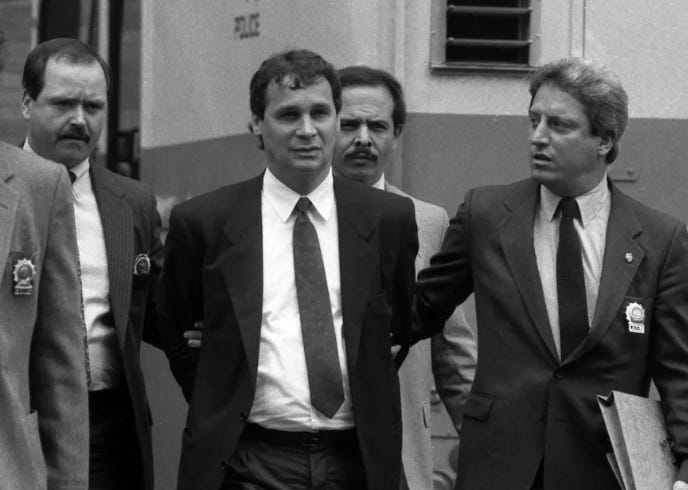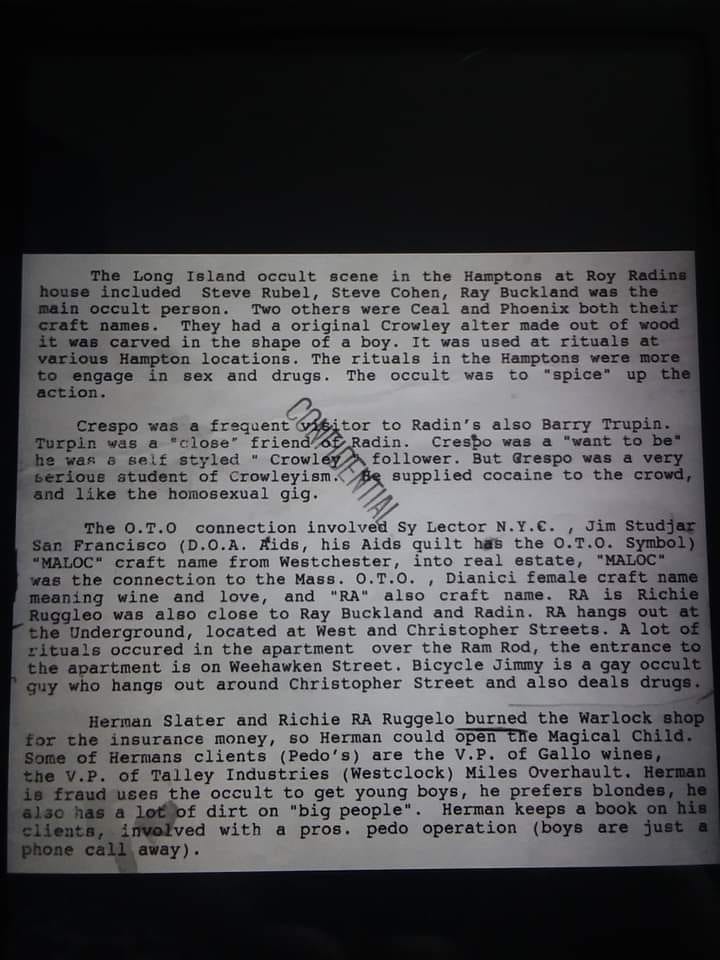Andrew Crispo following his conviction on tax evasion charges, November 1985
Bernard LeGeros, a young employee of wealthy Manhattan art dealer Andrew Crispo, was convicted of the February 22, 1985 murder of fashion student Eigil Dag Vesti in Tomkins Cove, New York. LeGeros admitted that he shot Vesti twice in the back of the head, but said that the murder was orchestrated by Crispo himself. Crispo, while acknowledging his presence at the scene, maintained that he had not ordered LeGeros to kill the masked and handcuffed Vesti. In the end, Crispo was not charged, though he was sentenced to prison for tax evasion. (LeGeros was paroled in 2019; Crispo died in 2024.)
In The Ultimate Evil, Maury Terry noted Crispo’s connection to Roy Radin, the art dealer’s name having appeared on the guest list for Radin’s wedding in 1981. (Radin’s link to the Son of Sam case is well-established.) What appears to be a police intelligence document—undated, and shared by Maury Terry on Facebook—names Crispo as “a frequent visitor” to Radin’s home in Southampton, Long Island (see below). This document states that the rituals conducted in the Hamptons were oriented primarily around sex and drugs, but that various occult trappings (including a boy-shaped altar once owned, allegedly, by notorious ceremonial magician Aleister Crowley) were used to enliven the proceedings. The implication is that most of the attendees were simply there to party, but a distinction is made with regard to Andrew Crispo. He’s characterized as “a ‘want-to-be’” and “a ‘self-styled’ Crowley follower,” but the document goes on to say that “Crespo [sic] was a very serious student of Crowleyism.”
The reader, then, will not be surprised to learn that Crispo’s serious interest in the occult was coroborated by Bernard LeGeros. According to Dr. Frank Varess (a Manhattan psychiatrist who examined the young man), LeGeros had fingered Crispo as a member of “a satanic cult which drank the blood of its victims” (The Ultimate Evil, pg. 621 of the 1989 paperback edition). LeGeros said that Crispo had ordered him to shoot Vesti twice—once to kill him physically, and again to kill his soul—and that a knife wound was made in the victim’s body. After a blood-drinking ritual (“We always drink the blood in the cult,” Crispo told LeGeros), Vesti’s body was burned.
A few more details can be found in David France’s Bag of Toys: Sex, Scandal, and the Death Mask Murder (1992), an interesting account of Crispo’s descent into violent madness under the influence of cocaine (though the author completely deemphasizes the occult aspect of the case). “(A) hole was dug in Vesti’s side with a black-handled hunting knife,” France wrote, “and his blood was let into one of the cups Crispo had packed in his nylon bag. ‘I tried to drink it,’ Bernard said, ‘but it was pulpy—I spit it out’.” (Bag of Toys, pg. 274 of the hardcover edition.)
Courtroom sketch of Bernard LeGeros by Ida Libby Dengrove“We always drink the blood in the cult.” Clearly, Andrew Crispo had come prepared to do exactly that. What did the murder of Eigil Dag Vesti represent to Crispo, who was said to have been such a devoted student of Crowleyism? Was the “want-to-be” eager to demonstrate the depth of his commitment? Only Crispo, LeGeros and the victim were present (by contrast, the murder of Etan Patz reportedly occurred in a group setting), and there is no indication that a greater number of people were intended to witness the killing. But it was premeditated and methodical: Crispo actually intended to drink human blood that night, and brought along the cups to drink it from. And he explained that this was a customary ritual for the cult to which he belonged. Was Crispo following a standard operating procedure? Had he heard about other ritual human sacrifices that were conducted in this manner? Had he witnessed such sacrifices?
Andrew Crispo’s ex-boyfriend Sam Collins said that he believed Crispo was incapable of killing anyone. Collins admitted, however, that Crispo often brought up the subject of snuff films and claimed that bodies were buried in his yard. (Likewise, Anthony Haden-Guest—author of a story about Crispo in New York magazine—told Maury Terry that “Crispo had spoken about snuff films and a contact for them in Houston” [The Ultimate Evil, pg. 619 of the paperback edition].) While no evidence of such bodies was ever found on Crispo’s property (why would he have buried them in his own back yard, after all?), it goes without saying that all the snuff film chatter places Crispo, once again, squarely within the Roy Radin/Ron Sisman milieu…which leads us right back to Son of Sam. Andrew Crispo’s name will forever be associated with the murder of Eigil Dag Vesti, but it’s possible that the late art dealer isn’t half as notorious as he deserves to be. The entire case warrants a detailed reexamination.
Eigil Dag Vesti, 1959-1985(PS: Some odd and possibly relevant information emerged during the testimony of Bernard LeGeros’s parents, which is quoted in David France’s book. His mother, Racquel, called Bernard an “oddity” and noted that, at the age of fifteen, he believed himself to be possessed by aliens. Racquel conceded that checking newborn Bernard into a “dormitory of infants” in Yonkers and seeing him only on weekends may have resulted in psychological and emotional trauma for her son [see pg. 323 of the hardcover edition of Bag of Toys]. John, Bernard’s father, told police that Bernard believed he had been drugged and raped by Sam Collins, Crispo’s ex-boyfriend; further, Bernard told his father that he was “sent to a mental home in the Midwest” [pg. 304]. Bernard LeGeros’s background, too, merits a closer look.)
(PPS: And yes, that’s the infamous cult leader Mr. Real Estate who receives a namecheck—as “MALOC,” a phonetic misspelling—in the document pictured earlier in this article. Was “Mr. Real Estate” a composite? It’s possible, since Maury Terry used composites. But he appears to have been entirely convinced that James Donovan, whose wife operated a real estate office, was the individual in question. There are, of course, differing views as to the identity of Mr. Real Estate/Moloch.)







